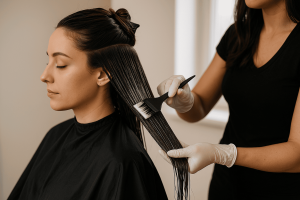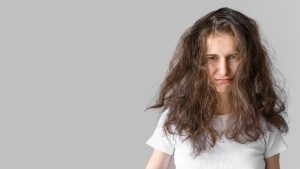The hairdressing industry is undergoing a constant revolution driven by technological advances, a growing demand for sustainability and an increasingly personalised approach to satisfy a diverse clientele.
In the digital era, traditional hairdressing is transforming, adopting new techniques and tools that allow for a more personalised and environmentally friendly experience. Adapting to these trends is key for salons to meet the expectations of today’s customers and stand out in an increasingly competitive market.
In this Milano Cosmetics article, we will explain the main innovations and trends in hairdressing salons, ranging from the digitisation of salons to the rise of eco-friendly products. These trends, in addition to improving the customer experience, open up new business and optimisation opportunities for salon professionals.

Technology in the salon: digitisation and advanced tools
Technology has begun to play an essential role in hairdressing salons, facilitating management and enhancing service quality. From management software to advanced hair diagnostic tools, digitalisation optimises salon operations and allows for more personalised service.
Online booking systems not only facilitate appointment management, but also minimise waiting times and improve daily organisation, allowing staff to focus more on service and less on logistics.
Another prominent trend is the use of artificial intelligence (AI) to personalise product and service recommendations. AI can analyse each customer’s hair type, proposing specific treatments and advising on the products that best suit their needs.
In addition, augmented reality (AR) and virtual reality (VR) experiences are beginning to transform the salon consultation, allowing clients to visualise different styles and colours in real time before making a decision. These technological advances not only improve customer satisfaction, but also increase loyalty and reduce returns due to unmet expectations.
New colouring techniques and cutting styles
The hairdressing market is constantly evolving in terms of colouring and cutting techniques, responding to a demand for more natural and personalised looks. Among the most popular colouring techniques are balayage, natural-looking shades and subtle gradients that seek to highlight the unique beauty of each individual.
Not only do these techniques offer more delicate aesthetic results, but they also require less maintenance, making them especially appealing to clients with busy schedules.
In terms of cuts, trends are leaning towards customisation based on natural hair texture and face type. Styles such as the bob or layered cuts adapted to the shape of the face are examples of how today’s hairdressing focuses on enhancing individual features, creating personalised looks that reflect each client’s style.
Personalised customer experience
Personalisation of the experience is one of the cornerstones of today’s hairdressing industry. More and more clients are looking for their salon visits to be unique and tailored to their specific needs.
In this sense, the analysis of each client’s personal characteristics, such as colourimetry and face shape, allows for the creation of fully personalised treatments and styles. This trend not only improves customer satisfaction, but also fosters loyalty, as personalisation offers a more complete and differential service.
In addition, many salons have started to implement post-service follow-up systems, where clients are recommended to use specific products to maintain the style at home. These personalised recommendations add value to the salon experience and strengthen the relationship between client and stylist, encouraging clients to return to the same salon.
Sustainability and eco-friendly products
Sustainability is increasingly relevant in the hairdressing industry, driven by consumer demand for more responsible practices and environmentally friendly products. Many salons are adopting sustainable measures, such as using biodegradable products and recyclable packaging, as well as choosing hair colours and treatments that are free of harmful chemicals. This change not only responds to an environmental need, but also attracts a conscious clientele who value the salon’s commitment to the environment.
In addition to sustainable products, some salons are incorporating practices to reduce their energy consumption, such as the use of LED lighting and energy-saving devices. These initiatives help to reduce the salon’s carbon footprint and, at the same time, can be a value-added argument to attract and retain an environmentally conscious clientele.
New consumer trends in the hairdressing sector
In terms of consumption patterns, one of the most prominent changes is the demand for inclusive and gender-neutral services. More and more salons are choosing to offer cuts and styles that are not divided by gender, responding to a diverse clientele and removing traditional barriers in service. This trend towards inclusive hairdressing allows clients to choose services according to their preferences, promoting a welcoming and label-free environment.
Another emerging trend is that of multi-sensory services in salons, ranging from aromatherapy to personalised ambience with music and light. These types of experiences make the salon visit more than just a haircut, turning it into a moment of relaxation and well-being. Multi-sensorial services, combined with personalised attention, increase customer satisfaction and make every visit special.

Digital marketing and social media for hairdressers
Digital marketing is an important tool for the growth of hairdressing salons. A strong social media presence allows salons to showcase their work, engage with clients and attract a wider audience. Platforms such as Instagram and Facebook are ideal for posting visual content, showcasing cutting and colour techniques, and sharing client testimonials. In addition, these social networks help to position the salon in its local area, achieving greater visibility.
On the other hand, online review management is essential to attract new clients. Many people consult reviews before choosing a salon, so having positive reviews and responding to comments can improve reputation and build trust. At a local level, tools such as Google My Business are also valuable for appearing in searches by people looking for services in your area, optimising the salon’s SEO and ensuring greater client acquisition.
The hairdressing industry is rapidly transforming, driven by technological advances, sustainability and increasingly personalised service. Embracing these innovations allows salons to not only improve customer satisfaction, but also to stand out in a competitive and constantly evolving market.






